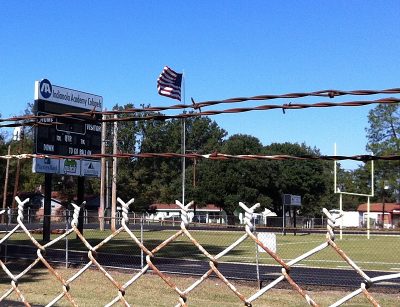Private academies keep students separate and unequal 40 years later
Indianola, Miss – It took LaToysha Brown 13 years to see the elephant in the room, and another few years to decide that it did not belong there.
When she was in the seventh grade, she began studying the civil rights movement at an after-school program called the Sunflower County Freedom Project. Only then did the 13-year-old become conscious of how little interaction she had with her white peers in this Mississippi Delta town: not at church, not at school, not anywhere.
It didn’t bother her at first. By high school, however, Brown had started to wonder if separate could ever be equal. She attended a nearly all-black high school with dangerous sinkholes in the courtyard, spotty Internet access in the classrooms, and a shortage of textbooks all around. Brown had never been inside Indianola Academy, the private school most of the town’s white teenagers attend. But she sensed that the students there had books they could take home and walkways free of sinkholes.
 For decades, Indianola Academy has used a football field adjacent to public school property. A barbed wire fence aims to keep trespassers out. (Photo by Sarah Carr)“The schools would achieve so much more if they would combine,” said Brown, now age 17 and a junior.
For decades, Indianola Academy has used a football field adjacent to public school property. A barbed wire fence aims to keep trespassers out. (Photo by Sarah Carr)“The schools would achieve so much more if they would combine,” said Brown, now age 17 and a junior.
More than four decades after the creation of a network of “segregation academies” in Mississippi Delta towns like Indianola, however, the secretive schools continue to define nearly every aspect of community life.
A Hechinger Report analysis of private school demographics (using data compiled on the National Center for Education Statistics website) found that more than 35 such academies survive in Mississippi, many of them in
When she was in the seventh grade, she began studying the civil rights movement at an after-school program called the Sunflower County Freedom Project. Only then did the 13-year-old become conscious of how little interaction she had with her white peers in this Mississippi Delta town: not at church, not at school, not anywhere.
It didn’t bother her at first. By high school, however, Brown had started to wonder if separate could ever be equal. She attended a nearly all-black high school with dangerous sinkholes in the courtyard, spotty Internet access in the classrooms, and a shortage of textbooks all around. Brown had never been inside Indianola Academy, the private school most of the town’s white teenagers attend. But she sensed that the students there had books they could take home and walkways free of sinkholes.
 For decades, Indianola Academy has used a football field adjacent to public school property. A barbed wire fence aims to keep trespassers out. (Photo by Sarah Carr)
For decades, Indianola Academy has used a football field adjacent to public school property. A barbed wire fence aims to keep trespassers out. (Photo by Sarah Carr)More than four decades after the creation of a network of “segregation academies” in Mississippi Delta towns like Indianola, however, the secretive schools continue to define nearly every aspect of community life.
A Hechinger Report analysis of private school demographics (using data compiled on the National Center for Education Statistics website) found that more than 35 such academies survive in Mississippi, many of them in
